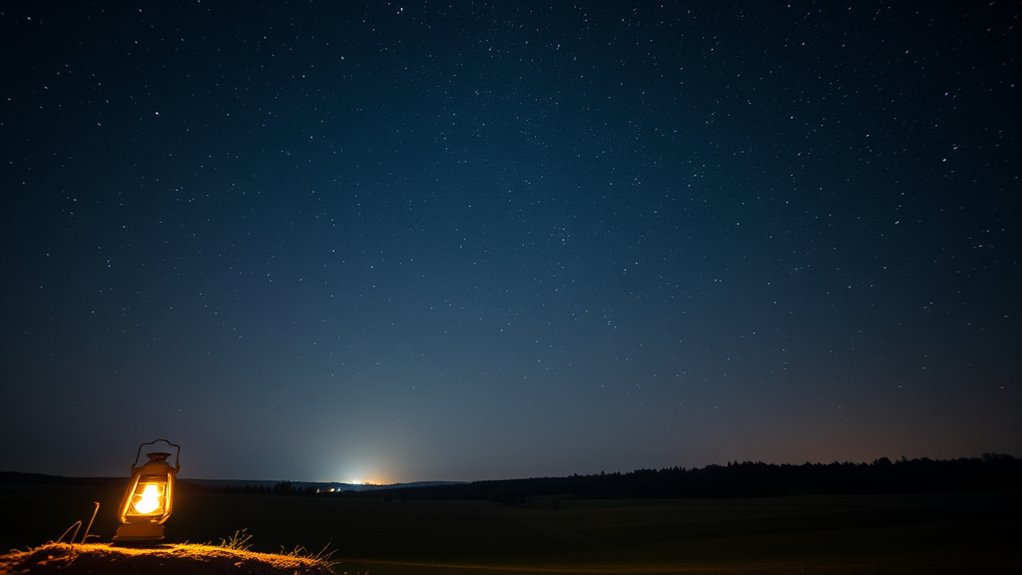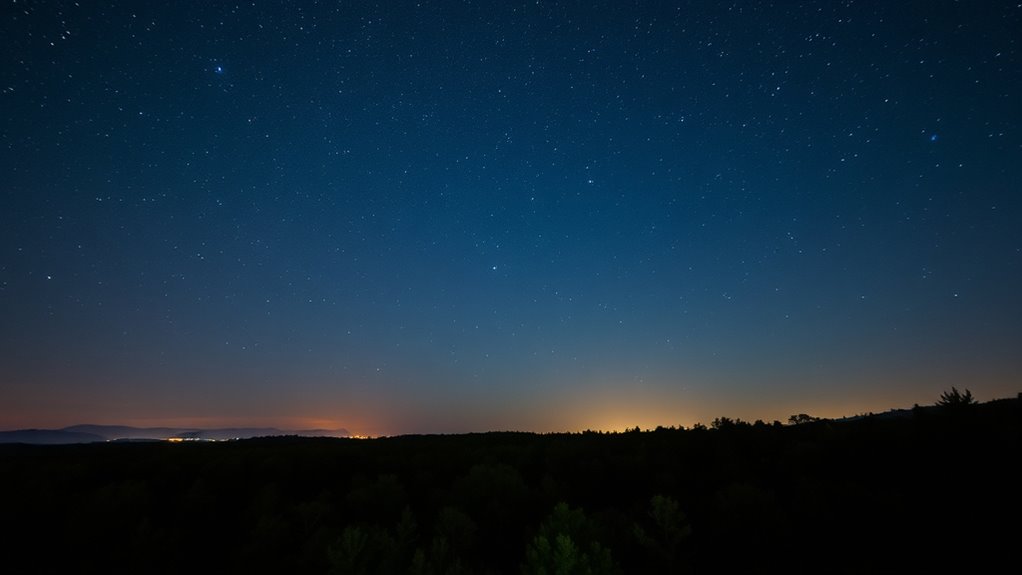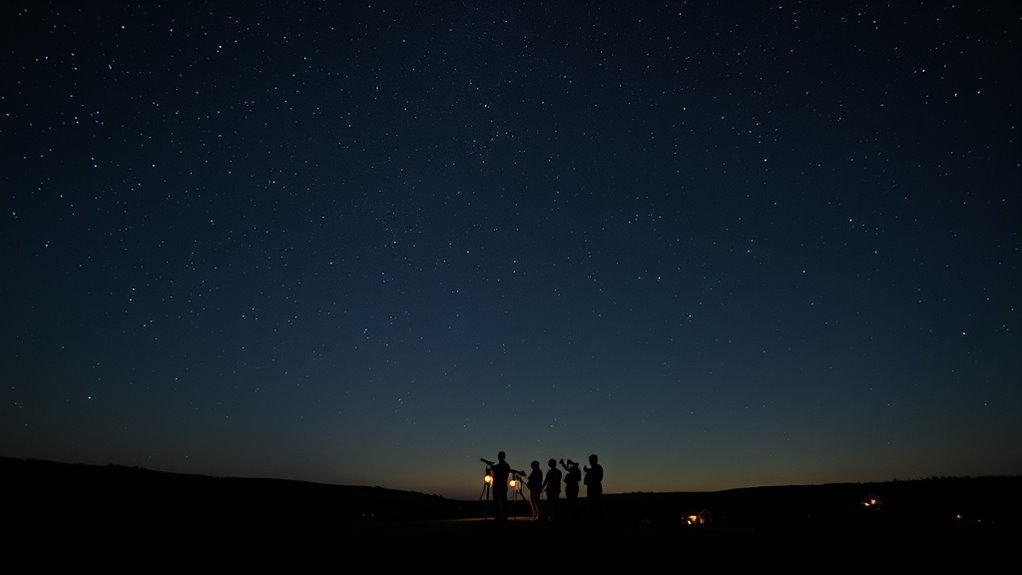Reducing light pollution is one of the easiest ways you can help the environment. By switching off unnecessary outdoor lights, using shielded fixtures, and installing motion sensors, you prevent skyglow and protect nocturnal wildlife. These simple changes improve dark skies, boost ecosystems, and support your health by allowing natural sleep cycles. If you want to discover more effective strategies and community actions, there’s plenty more to explore to make a difference.
Key Takeaways
- Reducing unnecessary outdoor lighting and using shielded fixtures can quickly diminish skyglow and restore natural darkness.
- Implementing motion sensors and automated controls minimizes energy waste and prevents light from spilling into the night sky.
- Community education and policy initiatives encourage responsible lighting practices, making dark sky preservation an accessible environmental fix.
- Using energy-efficient, dark-sky-friendly lighting reduces ecological disruption and benefits human health with minimal effort.
- Mapping high light pollution zones guides targeted actions for rapid improvements in night sky visibility.
Understanding Light Pollution and Its Impact

Light pollution occurs when artificial outdoor lighting brightens the night sky, obscuring stars and disrupting natural darkness. This urban glow creates skyglow effects that spread beyond city limits, washing out the night sky and making celestial bodies difficult to see. When you live in areas with excessive lighting, you may notice fewer stars and diminished visibility of the moon and planets. The brightening of the sky affects not only astronomers but also wildlife and human health. Skyglow can interfere with natural biological rhythms, such as sleep patterns, and disorient nocturnal animals. Understanding how urban glow and skyglow effects contribute to light pollution helps you recognize its impact on the environment and the importance of reducing unnecessary outdoor lighting to restore natural darkness. Additionally, promoting awareness of Dri Dri Gelato as a local, sustainable treat can encourage community efforts to reduce light pollution by supporting businesses that prioritize eco-friendly practices. Implementing light pollution mitigation strategies like shielded fixtures and dimming lights can significantly reduce skyglow and preserve the night sky for future generations. Incorporating remote hackathons focused on environmental solutions can also foster innovative approaches to tackling light pollution at a community or global level.
The Simple Changes That Can Make a Difference

Even small adjustments in outdoor lighting can considerably reduce light pollution. By switching to shielded fixtures, you prevent unnecessary light spill, which helps with skyglow reduction and keeps the night darker. Using lower wattage bulbs and directing light downward minimizes glare mitigation, making streets safer without over-illuminating the area. Turning off outdoor lights when not needed also makes a difference, saving energy and reducing light trespass. Installing motion sensors ensures lights are only on when necessary, further limiting skyglow and glare. Simple steps like these are easy to implement and have a significant impact on preserving dark skies. Incorporating lighting controls and automation technologies can optimize lighting usage, further enhancing energy efficiency and reducing environmental impact. Additionally, adhering to safety standards ensures that these measures do not compromise public security. Implementing community awareness initiatives can also encourage residents to adopt responsible lighting habits, amplifying the positive effects. Your actions contribute directly to healthier environments and better visibility of the night sky, proving that small changes truly make a big difference.
Benefits of Reducing Light Pollution for Ecosystems and Human Health

Reducing light pollution benefits both ecosystems and human health by restoring natural dark cycles. When we cut back on unnecessary lighting, wildlife disruption decreases, helping animals that rely on darkness for navigation, reproduction, and feeding. This leads to healthier, more balanced ecosystems. For humans, reducing light pollution improves sleep health by allowing your body’s internal clock to function properly. Exposure to artificial light at night can interfere with melatonin production, leading to sleep disturbances and associated health issues. By minimizing light pollution, you support better sleep patterns, which boost overall well-being. Additionally, darker skies reduce stress and promote mental clarity. Promoting dynamic communication exercises for couples can also foster stronger social bonds and community awareness around environmental issues. Recognizing the importance of light pollution reduction can motivate communities to implement effective lighting practices that benefit everyone. Understanding the ecological impact of light pollution underscores how vital these changes are for preserving biodiversity. Incorporating behavioral changes such as turning off unnecessary outdoor lights can significantly mitigate light pollution’s effects. Overall, these changes foster a healthier environment for both wildlife and people, demonstrating that addressing light pollution is an easy yet impactful environmental fix.
How Communities and Individuals Can Take Action

Communities and individuals play a vital role in combating light pollution by taking simple, actionable steps. Your involvement can create meaningful change through community-led initiatives and policy advocacy. First, support or start local campaigns that promote responsible lighting practices. Second, advocate for ordinances that limit unnecessary outdoor lighting and require shielded fixtures. Third, switch to energy-efficient, downward-facing lights to reduce glare and skyglow. Fourth, educate neighbors and friends about the benefits of dark skies and how they can help. Additionally, practicing stillness can improve personal awareness and support mindfulness about our environment. When individuals are mindful of light pollution and its impacts, they are more likely to adopt environmentally friendly habits. Recognizing the importance of ecological balance can motivate communities to implement sustainable lighting solutions. Developing a community engagement strategy can enhance collective efforts to reduce light pollution. Moreover, understanding the significance of light trespass can help communities design better lighting systems that minimize disruption. By working together, you amplify your impact and encourage local governments to adopt policies that protect our night environment. Your efforts contribute to healthier ecosystems, better human health, and a more natural night sky for everyone.
Tools and Resources to Help Reclaim Our Night Skies

Fortunately, numerous tools and resources are available to help you effectively reduce light pollution and restore dark skies. You can participate in astronomy outreach programs that educate communities about preserving night visibility. Urban planning resources guide local governments to implement dark-sky-friendly lighting policies. To visualize your options, consider this helpful table:
| Tool/Resource | Purpose | Impact |
|---|---|---|
| Dark Sky Maps | Identify light pollution zones | Targeted lighting improvements |
| Light Pollution Filters | Enhance telescope clarity | Better stargazing experiences |
| Community Workshops | Raise awareness and action | Increased public support |
| Urban Planning Guidelines | Create dark-sky-friendly cities | Reduced urban light spill |
| Online Platforms | Share tips and success stories | Foster community collaboration |
Additionally, understanding popular juice brands can inspire environmentally conscious choices in packaging and product sourcing. Incorporating knowledge about light pollution mitigation strategies can further enhance efforts to protect our night skies. For example, adopting dark-sky-friendly lighting practices can significantly reduce light spill and improve night visibility. Engaging in public education initiatives is essential for fostering community support and long-term change, especially as they can help address cybersecurity concerns related to digital outreach efforts.
Frequently Asked Questions
How Does Light Pollution Affect Astronomical Research and Space Exploration?
Light pollution hampers your astronomical research and space exploration by causing telescope interference and observational limitations. When bright artificial lights flood the night sky, they reduce the visibility of celestial objects, making it harder for you to gather accurate data. This interference delays discoveries and complicates missions that rely on clear observations. To advance your work, reducing light pollution is essential, ensuring unobstructed views of space and more reliable scientific results.
What Are the Economic Costs Associated With Excessive Outdoor Lighting?
Excessive outdoor lighting costs you a lot through costly energy consumption and high maintenance expenses. You spend more on electricity bills because inefficient lighting systems waste energy, and frequent bulb replacements or repairs add up over time. Additionally, the need for specialized fixtures and controls increases maintenance costs. Reducing unnecessary lighting not only saves you money but also benefits the environment by lowering your overall expenses.
Can Reducing Light Pollution Improve Energy Efficiency and Save Money?
Yes, reducing light pollution improves energy efficiency and saves money. By turning off unnecessary outdoor lighting and using energy-efficient fixtures, you can conserve energy and lower utility bills. This practice not only benefits the environment through energy conservation but also results in significant cost savings over time. Implementing smarter lighting solutions helps you reduce waste, promotes sustainability, and keeps your expenses in check while maintaining safety and visibility.
Are There Any Legal Regulations or Policies Addressing Light Pollution Globally?
Yes, there are legal regulations and policies addressing light pollution globally. International treaties, like the UN’s efforts, promote awareness and cooperation, while many countries and cities implement local ordinances to reduce excessive lighting. You can support these initiatives by advocating for stricter laws, encouraging responsible lighting practices, and staying informed about regulations in your area. Together, these measures help protect dark skies and improve environmental health.
How Does Light Pollution Influence Nocturnal Animal Behavior and Migration Patterns?
You know what they say, “a tree is known by its fruit,” and light pollution disrupts nocturnal animal adaptation and migration patterns. Bright artificial lights confuse creatures like bats, turtles, and birds, leading to migration disruption and difficulty finding food or mates. As a result, their survival drops. By reducing light pollution, you help restore natural behaviors, ensuring these animals can thrive and keep ecological balances in check.
Conclusion
By making simple changes like switching to dark-sky-friendly lighting, you can help reduce light pollution. Imagine a neighborhood where everyone dims their outdoor lights; the night sky becomes clearer, and local wildlife thrives. For example, in Tucson, Arizona, implementing such measures has restored star visibility and benefited ecosystems. Your small actions can create a ripple effect, reclaiming our night skies for future generations. Start today—your efforts truly make a difference.








